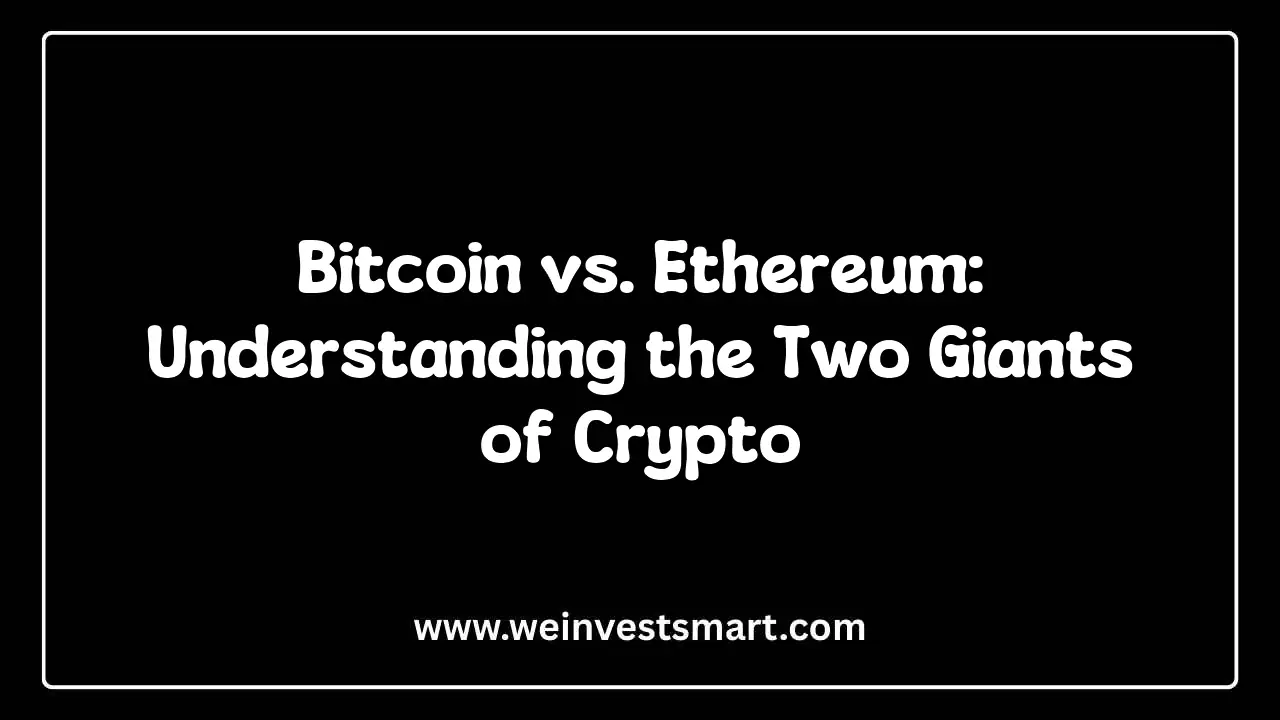· WeInvestSmart Team · cryptocurrency · 10 min read
Beyond the Blue Chips: A Beginner’s Guide to Altcoins and Stablecoins
The crypto ecosystem is more than just Bitcoin and Ethereum. This guide demystifies the world of altcoins (alternatives to Bitcoin) and explains the crucial role of stablecoins (like USDC) as the essential plumbing of the digital economy.
Most people, when they think about cryptocurrency, see a landscape dominated by two colossal mountains: Bitcoin and Ethereum. They are the “blue chips,” the household names that get all the media attention and institutional investment. For many, they are the entire market. But here’s the uncomfortable truth: focusing only on Bitcoin and Ethereum is like visiting New York City and never leaving Times Square. You’ve seen the brightest lights, but you’ve missed the sprawling, chaotic, and infinitely more interesting city that surrounds it.
The reality is that the crypto ecosystem is a teeming jungle of thousands of different digital assets, each with its own purpose, community, and risk profile. This jungle is where fortunes are made and lost in the blink of an eye. It’s where the most radical experiments are happening, and it’s where the future of this technology is being forged in real-time.
Going straight to the point, this vast world can be broken down into two other massive categories you must understand: Altcoins and Stablecoins. One represents the wild frontier of high-risk innovation, and the other provides the essential, stabilizing plumbing that allows the whole system to function. And this is just a very long way of saying that if you want to be a serious investor in this space, you have to look beyond the two giants on the horizon.
The Wild Frontier: Altcoins (The Dot-Com Boom of Digital Assets)
So, what is an altcoin? The definition is almost comically simple. An altcoin is any cryptocurrency that is not Bitcoin. It’s short for “alternative coin.” That’s it. From Ethereum (which was the first and is still the biggest altcoin) down to the most obscure and nonsensical meme coin, they all fall under this massive umbrella.
But why do they exist? If Bitcoin is the original “digital gold,” why do we need thousands of alternatives? Here’s where things get interesting. The explosion of altcoins is best understood through an analogy: the early days of the internet.
Think of Bitcoin as the invention of the email protocol (SMTP). It was a technological miracle—a way to send a message from anyone to anyone, anywhere in the world, without a central authority. It had one job, and it did it brilliantly. But it was limited.
The creators of altcoins looked at Bitcoin’s underlying blockchain technology and said, “This is amazing, but what else can we do with it?” This led to an explosion of experimentation, mirroring the dot-com boom of the late 1990s:
- Some wanted to build a better email: These are the altcoins that aim to be a “better” Bitcoin—faster, more efficient, or more private. Litecoin was one of the earliest examples, branding itself as the “silver to Bitcoin’s gold.”
- Some wanted to build the entire World Wide Web: This is Ethereum. Its creators realized the blockchain could be used not just to send messages (money), but to run entire applications (smart contracts). This created the foundation for everything from decentralized finance (DeFi) to NFTs.
- Some wanted to build specialized applications: These are the altcoins with a very specific use case. Filecoin, for example, aims to create a decentralized market for digital storage, like a global, user-owned Dropbox.
And, of course…
- Some just wanted to sell pet food online: Many altcoins, particularly the infamous “meme coins” like Dogecoin or Shiba Inu, have no real technological innovation or utility. They are purely speculative assets driven by hype, community, and social media trends. They are the Pets.com of the crypto world.
The Brutal Risk/Reward Profile of Altcoins
The single most important thing to understand about altcoins is that they exist on the extreme end of the risk spectrum. They represent a venture capital-style bet on early-stage, experimental technology.
- The Potential Reward: If you manage to invest in the rare altcoin that solves a real problem, gains widespread adoption, and becomes a foundational piece of the next-generation internet, the returns can be astronomical—100x or even 1,000x your initial investment.
- The Almost Certain Risk: The funny thing is, the vast, overwhelming majority of altcoins will fail. They will go to zero. They will be out-competed, their technology will prove unworkable, their founding team will abandon the project, or they will turn out to be outright scams. For every Amazon, there were a thousand failed e-commerce sites. The same is true here.
Investing in altcoins is not like buying a blue-chip stock. It is a high-stakes bet that requires deep technical understanding, a tolerance for gut-wrenching volatility, and the willingness to lose your entire investment.
You may also be interested in: Hot Wallets vs. Cold Wallets: The Essential Guide to Storing Your Crypto Securely
The Essential Plumbing: Stablecoins (The Casino Chips of the Crypto Economy)
Now, let’s shift gears completely. If altcoins are the speculative, high-risk gambles happening at the tables, stablecoins are the casino chips that make all the games possible. They are the single most important, yet least understood, piece of infrastructure in the entire crypto economy.
So, what is a stablecoin? Going straight to the point, a stablecoin is a type of cryptocurrency whose value is pegged to a stable “real-world” asset, most commonly the U.S. dollar. The goal is to create a digital asset that always maintains a price of, for example, $1.00. The most prominent examples are USD Coin (USDC) and Tether (USDT).
But why would we need a “stable” crypto? Isn’t the whole point the volatility and potential for massive gains? This is a classic beginner’s mistake. The extreme volatility of assets like Bitcoin and altcoins makes them terrible for actual commerce or for holding value day-to-day.
Imagine the chaos of the crypto market as a massive, 24/7 digital casino.
- The tables (Bitcoin, Solana, Dogecoin) are where the wild price swings happen.
- The “bank teller” window that connects this casino to the real-world banking system (your traditional bank account) is slow, expensive, and only open during business hours. It can take days to move your money in or out.
This creates a huge problem. What do you do when you want to take your profits off a volatile table but don’t want to leave the casino entirely? You can’t just leave your money on the table, as its value could crash by 20% overnight. This is the problem stablecoins were invented to solve.
The Analogy: A stablecoin is a casino chip. You can sell your Bitcoin and instantly convert it into USDC, which is like exchanging your poker winnings for a stack of $1 chips. Now your value is stable. You are protected from the market’s volatility, but you’re still “in the casino,” ready to place your next bet instantly, 24/7, without having to go through the slow process of cashing out to your real bank account.
How Do Stablecoins Stay Stable?
This sounds like magic, but it’s actually based on a very simple model, at least for the most reliable ones.
The dominant model is fiat-collateralization. Here’s how it works for a stablecoin like USDC:
- Creation: A company (in this case, Circle) creates a new USDC token.
- Backing: For every single USDC token created, the company holds one U.S. dollar (or an equivalent highly liquid, safe asset like a short-term U.S. Treasury bill) in a real, audited bank account or reserve.
- Redemption: You can, at any time, go to the issuer and redeem your 1 USDC for 1 U.S. dollar.
This 1:1 backing is what keeps the price pegged at $1. If the price of USDC on the open market ever dropped to $0.99, traders would rush in to buy it cheap and redeem it with the issuer for a full $1.00, making a risk-free profit. This arbitrage action quickly pushes the price back up to its $1 peg. In other words, its stability is based on the trust that the reserves are really there.
A note of caution: There are other, more complex types of stablecoins, like “algorithmic” ones, that try to maintain their peg using code instead of real-world collateral. These have proven to be dramatically riskier, as evidenced by the catastrophic collapse of the Terra/Luna ecosystem in 2022. For beginners, sticking to fully-backed, fiat-collateralized stablecoins is the only prudent choice.
The Crucial Role of Stablecoins
Their role as a “safe haven” from volatility is just the beginning. Stablecoins are the lifeblood of the modern crypto economy.
- They are the primary trading pair: On most crypto exchanges, assets are not priced in U.S. dollars; they are priced in USDT or USDC.
- They are the foundation of DeFi: Decentralized lending and borrowing platforms run on stablecoins. You can deposit your USDC and earn interest, or use it as collateral to borrow other assets.
- They are a bridge to the real world: They provide a fast, cheap, global way to move dollar-equivalent value across borders without relying on the slow, traditional banking system.
You may also be interested in: Bitcoin vs. Ethereum: Understanding the Two Giants of Crypto
The Bottom Line: Building Your Mental Model of the Crypto World
So, what do we do with this? How should a beginner think about this complex ecosystem? You must separate the concepts in your mind.
(Bitcoin as Digital Gold) + (Ethereum as the World Computer) + (Altcoins as Venture Bets) + (Stablecoins as Financial Plumbing) = The Complete Crypto Ecosystem
You cannot control which altcoin will become the next 100x winner. You cannot predict which ones are scams. But you have absolute, 100% control over your own education and your own risk management.
And this is just a very long way of saying that navigating the crypto world requires a diversified mental framework. You must recognize the difference between a long-term store of value (Bitcoin), a bet on the future of the internet (Ethereum), a high-risk gamble on experimental technology (altcoins), and the essential, stable infrastructure that holds it all together (stablecoins). Confusing one for the other is the fastest way to get yourself into trouble. Welcome to the jungle. Now you have a map.
Altcoins and Stablecoins FAQ
What are altcoins and stablecoins?
Altcoins are cryptocurrencies other than Bitcoin, often with specific use cases or innovations. Stablecoins are cryptocurrencies pegged to stable assets like the US dollar, providing stability in the volatile crypto market.
What are some examples of altcoins?
Examples of altcoins include Ethereum (smart contracts), Litecoin (faster transactions), Solana (high-speed blockchain), and meme coins like Dogecoin. Some altcoins have real utility like Chainlink (oracle services) or Polkadot (interoperability), while others are purely speculative.
How do stablecoins maintain their value?
Stablecoins maintain their value through collateralization. Fiat-collateralized stablecoins like USDC and USDT hold equivalent value in real assets (US dollars or Treasury bills) in reserve. Users can redeem tokens for the underlying asset, creating arbitrage opportunities that keep the price stable around $1.
Are altcoins safe to invest in?
Altcoins carry significantly higher risk than Bitcoin. Most altcoins fail and go to zero. While some can provide massive returns (100x+), investors should only allocate what they can afford to lose, conduct thorough research, and understand the project’s fundamentals, team, and use case.
What role do stablecoins play in crypto?
Stablecoins serve as the “plumbing” of the crypto ecosystem. They provide price stability for trading pairs on exchanges, enable fast transfers without volatility, support DeFi protocols for lending/borrowing, and act as a bridge between traditional finance and crypto markets.
This article is for educational purposes only and should not be considered personalized financial advice. Consider consulting with a financial advisor for guidance specific to your situation.



